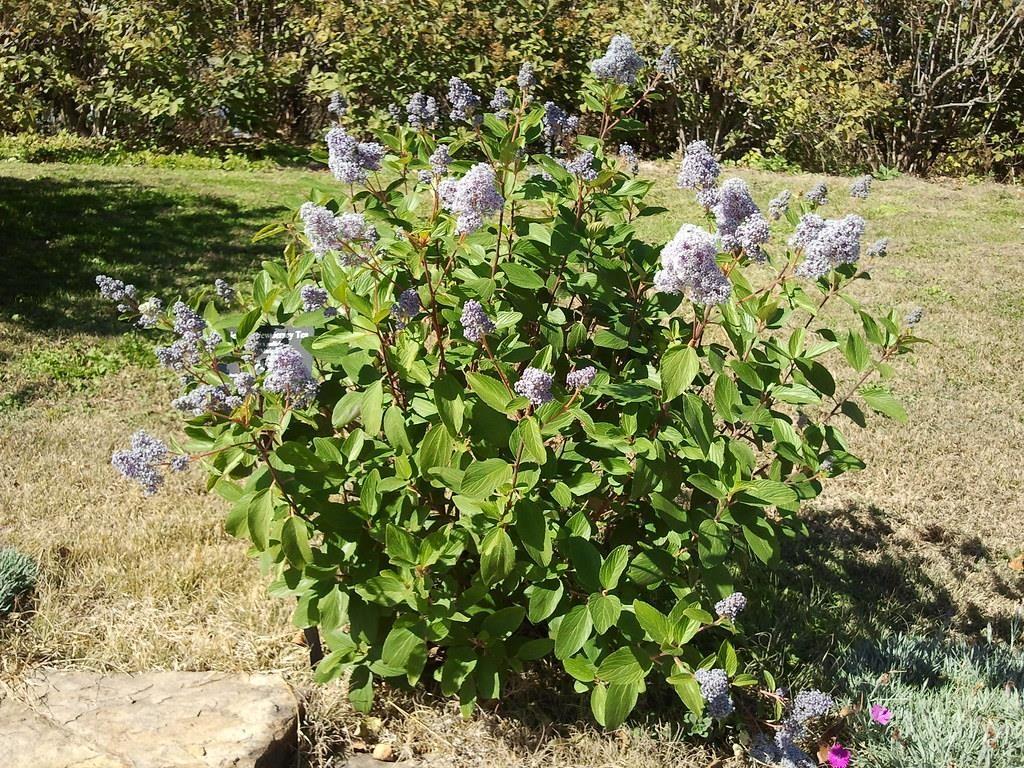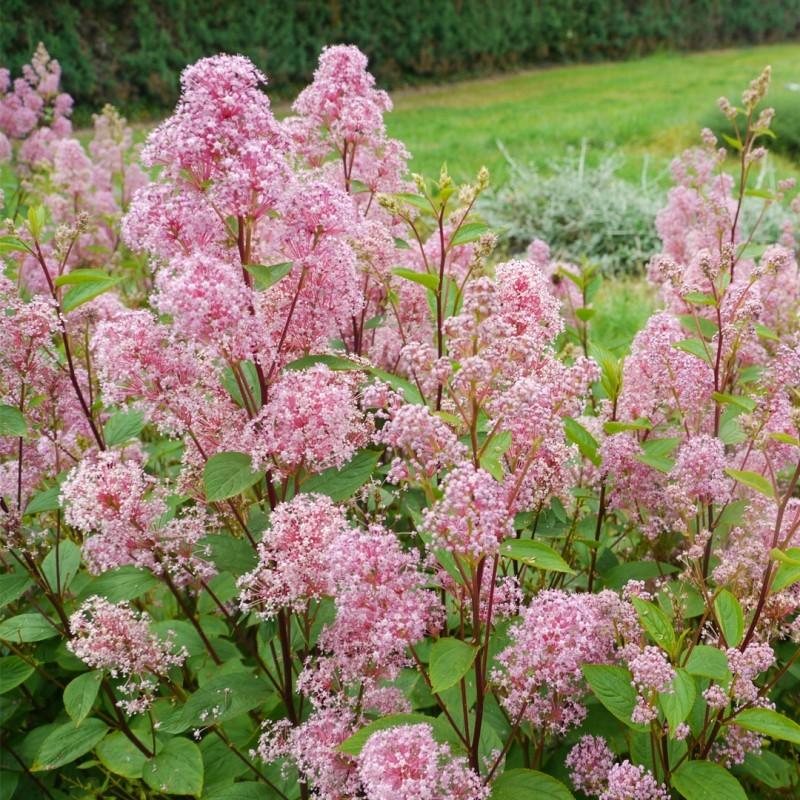Content
A photo and description of ceanothus gives a general idea of this culture. It is represented by a low shrub with numerous flowers, mostly blue. Ceanothus is not very winter-hardy, but it can be grown in the middle zone and more northern regions. You can learn about the features of planting and care from the presented article.
Description of ceanothus with photo
Ceanothus belongs to perennial shrubby plants from the buckthorn family. In nature, it grows in the United States and in the southeastern provinces of Canada. Therefore, this plant is often called California lily or New Jersey tea.
But the more common name is “redroot” or “red root.” The fact is that the tissues of the roots of the plant actually contain a pigment that gives them a characteristic reddish color.
Externally, the ceanothus shrub partly resembles lilac.It reaches a small height - 2-3 m (although there are also representatives up to 7 m). The stems of the plant are quite thin, twig-like. They are mostly smooth, although sometimes they are prickly.
The foliage of the ceanothus plant is arranged alternately, sometimes oppositely. The color of the plates is rich green, they are medium in size - from 1 to 5 cm in length. Basically, the leaves grow on well-defined petioles.
The flowers of the ceanothus plant are small in size and collected in paniculate inflorescences. Various colors:
- light purple;
- pure white;
- snow-white with a greenish tint;
- blue;
- light purple;
- pink.

Numerous flowers cover the entire crown of the bush
The calyxes are saucer-shaped, the lobes are quite thin, and have a narrowed triangular shape. A characteristic feature of the flowers is that the petals are longer compared to the sepals; they have an irregular shape, reminiscent of a ladle. Flowering generally occurs in June, although the timing may vary depending on the characteristics of the variety and the climate of the region.
Towards the end of summer, the ceanothus plant forms fruits - at first they are small, as they ripen they increase in size and become round in shape. They are covered with a thin shell and divided into three lobes, each of which contains one seed.
Types and varieties of ceanothus
There are several species of ceanothus, on the basis of which quite a few varieties and hybrids have been bred that produce fertile offspring. For convenience, plants are usually divided into two groups - evergreen and deciduous.
Evergreens
Among the evergreen species, the pyramidal ceanothus (Ceanothus Thryrsiflorus) can be distinguished. Based on it, breeders have developed several varieties:
- Conha - reaches a height of 2-3 m. The plant produces thin shoots and blue fragrant flowers.
- Skylark (Skylark) is distinguished by oval foliage of dark green color. The plant has blue inflorescences.
- Snow Flurry is a tall shrub (sometimes up to 7 m). The plant forms lush blue inflorescences.
- Repens Victoria (Repens Victoria) - ground cover. Ceanothus has soft lilac flowers.
Deciduous
Deciduous varieties of the ceanothus plant bloom closer to the second half of summer, sometimes even at the beginning of autumn. They produce low shrubs; among the most common varieties are the following:
- Topaz has attractive bright blue flowers.
- Marie Simon reaches 2 m. Gives pink flowers.
- The Perle Rose variety also decorates the garden with pink flowers.
Planting ceanothus in open ground
The plant is unpretentious and survives spring frosts normally. Therefore, planting begins quite early - from the second half of March to mid-April. It is advisable to do it before the leaves bloom. Specific dates depend on the climatic characteristics of the region:
- In the middle zone, planting of ceanothus is planned for the end of March.
- In the south - in mid-March.
- In the Urals, Leningrad region and neighboring regions of the North-West, ceanothus is planted in early April.
- In Siberia and the Far East, you can wait another week, but no later than mid-April.
It is better to choose and prepare a place for planting a ceanothus plant in advance. It should be assumed that the shrub is light-loving, although it needs protection from draft winds, especially from the north side of the garden. In addition, care must be taken to ensure that there is no stagnation of water. It is better to choose small hills rather than lowlands.
It is recommended to prepare the soil 1-2 months before planting or on the eve of autumn.The site is cleaned, the ground is dug up and organic or mineral fertilizers are applied. You can add, for example, half a bucket of humus per square meter.
The process of planting a ceanothus plant looks like this:
- Dig a not very deep hole (50*60 cm). If planting in groups, adjacent holes are formed at a distance of at least 70 cm.
- Place small stones on the bottom in a layer of 10 cm.
- Then add a fertile soil mixture, water it and leave it for several days.
- The seedlings are rooted in the center, the soil is lightly compacted. Moreover, this must be done so that the root collar remains flush with the surface.
- Then the ceanothus plant is watered with settled water and peat, rotted sawdust, hay or other mulch are laid.

Ceanothus grows in sunny places
Ceanothus care
The plant is unpretentious, although it grows well and requires regular pruning. In addition, you need to take into account that in the first year after planting, regular watering is especially important. Feeding can be done several times a season - thanks to this, flowering will be stable and the plant will not suffer from diseases.
Watering
Ceanothus is moisture-loving, so the plant should be watered twice a week with settled water. It is enough to give young seedlings half a bucket of water, and adults – the full bucket (10 l). During drought, watering is planned three times a week, but care is taken to ensure that the soil is not excessively wet.
To prevent the roots of the ceanothus plant from being damaged, use only settled water.It is first poured into containers and left overnight outside or indoors. After watering, it is advisable to loosen the soil and remove weeds if necessary. To keep the ground moist as long as possible, the tree trunk circle is mulched with peat, sawdust and other materials.
Top dressing
Fertilizers for the ceanothus plant are applied three times per season. This is quite enough to maintain health and long flowering:
- Fertilizers are given for the first time at the end of March, after the snow melts. It is necessary to water with sodium humate (2 tablespoons per 10 l), mullein solution 1:10 or nitrogen mineral fertilizer, for example, urea (20 g per 10 l).
- The second time the ceanothus plant is fed during the formation of buds. You can use a complex fertilizer with potassium and phosphorus or create it yourself. For example, take 40 g of superphosphate, 30 g of potassium sulfate and dissolve them in 10 liters.
- Next, fertilizers are applied 1-2 more times at intervals of 3-4 weeks. You can use complex formulations or an infusion of wood ash 200 g per 10 liters. At the very end of August, fertilizers are no longer given - otherwise the ceanothus plant will not have time to prepare for winter.
Trimming
Shrub pruning is carried out regularly, since it grows quickly and can take on an unattractive shape. In early spring, before sap flow begins, all old, frozen and dry branches of the plant should be removed, cutting them to a healthy place.

To form a beautiful crown, pruning is done every year.
Old shrubs can be rejuvenated by cutting off all the twigs “under the stump”, leaving only 5 cm above the ground. In the fall, if necessary, make a shaping haircut, removing all the branches of the plant that clearly extend beyond the general contour.
Wintering
The winter hardiness of ceanothus is estimated at -23 degrees.This suggests that the plant can easily overwinter in open ground not only in the south of Russia, but also in the middle zone and neighboring regions. On the other hand, in the Urals, Siberia and other areas with harsh winters, it is imperative to make a shelter.
Therefore, at the very end of September, a large layer of mulch is laid in the tree trunk circle (radius of at least 1 m). Peat, small sawdust or dry leaves are used to cover the ceanothus. Dense fiber is laid on top. In order for the ceanothus plant to quickly recover after winter, the mulch is removed in early spring.
Diseases and pests
The shrub has good immunity to fungal and other infections. However, the plant may suffer from iron deficiency (chlorosis), the symptoms of which can be easily determined visually:
- yellowing of young foliage (veins remain green);
- twisting the plates along the edges;
- falling of both foliage and flowers;
- drying of the upper parts of the shoots;
- death of root layers.
It is quite possible to prevent iron chlorosis. To do this, the ceanothus plant should be planted in soil with a slightly acidic or neutral reaction. In addition, it is recommended to water once a month with slightly acidified water (5 g of citric acid per 20 l). Along with this, it is recommended to give iron chelate, which can be purchased at the store or prepared independently.
As for pests, mealybugs and aphids pose a particular danger to the ceanothus plant. To prevent and control them, insecticides are used:
- "Inta-Vir";
- "Aktara";
- "Fufanon";
- "Karbofos".
Reproduction methods
The ceanothus plant is quite easy to propagate, especially by vegetative methods, for example, by cuttings.Growing from seeds is also practiced - each method is described in more detail below.

Most often, ceanothus is propagated by vegetative methods.
Growing ceanothus from seeds
Growing from seeds is quite labor-intensive, since they require preliminary stratification. The main stages are:
- Place the ceanothus seed in the refrigerator for three months.
- In early February, pour boiling water and leave to cool.
- Stratify again for a month in the refrigerator (preferably in the freshness zone at a temperature close to zero).
- Leave for several days and leave at room temperature to dry.
- Soak overnight in a growth stimulator, for example, Epin solution.
Next, ceanothus seeds are planted in fertile soil to a depth of 0.5 cm, greenhouse conditions are created and grown at room temperature. After 2-3 leaves appear, the plant is pruned. Then the ceanothus is fed with complex fertilizer, for example, “Baikal”. Redroot seedlings should be planted in open ground closer to the May holidays, when there will definitely be no return frosts.
How to grow ceanothus from cuttings
Ceanothus can also be grown from cuttings. Work will begin in late June. The sequence of actions is as follows:
- Young shoots of the plant are cut 10-12 cm long.
- I remove the lower leaves of the ceanothus and make a cut at an angle from below.
- Place the plant in a solution of “Kornevin” or another stimulant for several hours.
- Ceanothus is planted in fertile, well-moistened soil mixture.
- Cover with a transparent bottle and remove it periodically for watering and ventilation.
- At the beginning of autumn, they move the containers into the house and leave them for the winter.
- In the first half of April, seedlings of the ceanothus plant are transferred to a permanent place in open ground.
Reproduction by dividing the bush
Old bushes can be divided. This will allow the plant to propagate and also rejuvenate it. Work will begin at the end of March. The ceanothus bush is carefully dug up and divided into two equal parts. They try to preserve the root system as much as possible. Then the plants are transplanted to a new place at the same depth as before.
Reproduction by layering
There is also a way to propagate ceanothus by layering. At the end of spring, the side shoots are bent to the soil and placed in pre-made grooves 10 cm deep. They need to be placed so that the tip of the shoot remains on the surface. Sprinkle with soil, water and feed abundantly during the summer. At the beginning of autumn, all rooted parts are separated and planted in a permanent place.
Ceanothus can be propagated by layering in 2-3 months.
Conclusion
Photos and descriptions of ceanothus allow you to be inspired by the beauty of this plant, especially its numerous flowers. The crop is grown mainly in Central Russia, since winter hardiness is not the highest. As a last resort, you can plant them in pots - for the winter they are placed in a cool room with fairly good lighting.
Reviews from gardeners about ceanothus















